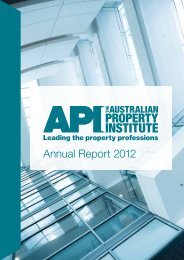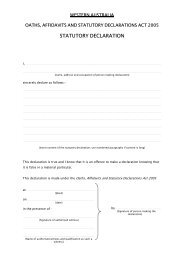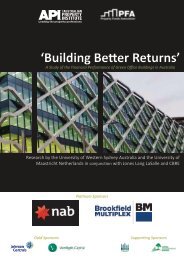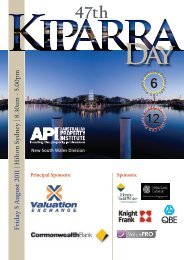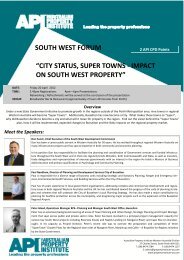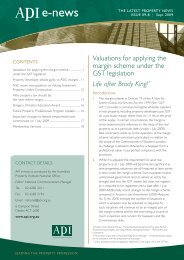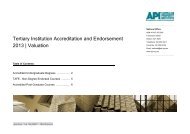VALUATIONS FOR INSURANCE PURPOSES
VALUATIONS FOR INSURANCE PURPOSES
VALUATIONS FOR INSURANCE PURPOSES
You also want an ePaper? Increase the reach of your titles
YUMPU automatically turns print PDFs into web optimized ePapers that Google loves.
ANZ VALUATION GUIDANCE NOTE 13<br />
rate assuming reasonable maintenance. However, there<br />
are types of plant and equipment, particularly those<br />
that experience rapid technological and functional<br />
obsolescence, for which other methods including the<br />
diminishing value method, are more appropriate.<br />
To the extent plant and equipment is valued on the<br />
basis of indemnity value using a market comparison<br />
approach, the indemnity value may comprise two<br />
components, depending on the nature of the asset. The<br />
first component is the cost of acquiring a comparable<br />
item of equipment from the second-hand market to<br />
which is added the (un-depreciated) cost of installing and<br />
commissioning that item.<br />
Members should include reference within their report/<br />
covering letter that a depreciated replacement cost based<br />
indemnity value may not be the same as one determined<br />
using a market comparison approach, and in some cases,<br />
the difference might be material.<br />
As for any other valuation, valuers should fully explain<br />
any assumptions, the methodology adopted and the<br />
reasoning that supports their conclusion as required by IVS<br />
3. This will invariably require information, which should<br />
be included in the insurance valuation report or covering<br />
letter.<br />
6.0 Report Content<br />
6.1 Buildings<br />
In addition to those items covered under IVS 1, IVS<br />
3 and ANZVGN 1, (and with reference to section<br />
2.5 of this Guidance Note) an insurance valuation<br />
report for buildings and site improvements should<br />
include, to the extent included within the agreed<br />
scope of work:<br />
• A brief description of assets including a clear<br />
statement as to whether floor coverings,<br />
internal partitions, fit-out or other services are<br />
included in or excluded from the valuation.<br />
• A reinstatement cost estimate and/or<br />
indemnity value estimate as at the date of<br />
inspection.<br />
• An estimate of the cost of demolition and<br />
removal of building debris.<br />
• An estimate of the cost increases during the<br />
policy period (this and the following two cost<br />
increase allowances are typically provided as<br />
separate inflationary estimates).<br />
• An allowance for cost increases during the<br />
lead time, i.e. the period after a major loss<br />
when debris is removed, building plans are<br />
drafted and necessary approvals are obtained.<br />
• An allowance for cost increases during rebuild<br />
period.<br />
• A statement as to the treatment of GST.<br />
• A statement of specific valuation exclusions<br />
such as plant, equipment tools, furniture,<br />
stock and materials in trade, and the costs of<br />
removal/disposal of these.<br />
• Reference to the method and extent of fire<br />
protection services.<br />
• A statement regarding the treatment of<br />
financing costs during reconstruction and<br />
whether it is assumed they are met by way of<br />
progress payments as costs are incurred.<br />
• Any relevant qualifications and disclaimers,<br />
which includes comments upon any unverified<br />
information or assessments of future events.<br />
Loss of rent/profits may also be required depending<br />
on the agreed scope of work.<br />
6.2 Plant and Equipment<br />
For plant and equipment assets, the report content should<br />
include or explain the following to the extent<br />
included within the agreed scope of work:<br />
• A brief description of the assets.<br />
• A reinstatement cost estimate and/or indemnity<br />
value estimate as at the date of inspection.<br />
• An estimate of the cost of demolition and<br />
removal of plant and equipment debris.<br />
• An estimate of the cost increases during the<br />
policy period (this and the following two cost<br />
increase allowances are typically provided as<br />
separate inflationary estimates).<br />
• An estimate of the cost increases during the<br />
lead time, i.e. the period after a major loss<br />
when debris is removed, building plans are<br />
drafted and necessary approvals are obtained<br />
(often any buildings housing plant will have<br />
to be reinstated before the plant can be<br />
reinstated) plus any additional lead time<br />
associated with the plant reconstruction and<br />
installation. This period can be substantial.<br />
Because inflation and, if applicable, foreign<br />
exchange rate changes can be volatile, any such<br />
estimates will require qualification.<br />
• The treatment of obsolete assets. It is common<br />
ANZVGN 13 <strong>VALUATIONS</strong> <strong>FOR</strong> <strong>INSURANCE</strong> <strong>PURPOSES</strong><br />
8.13.9



